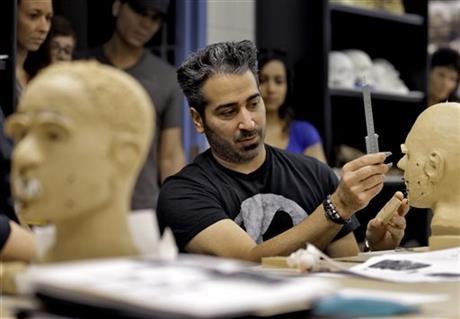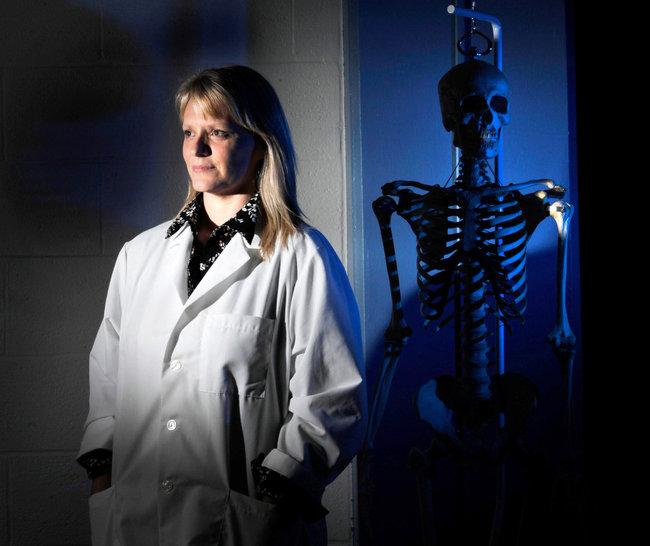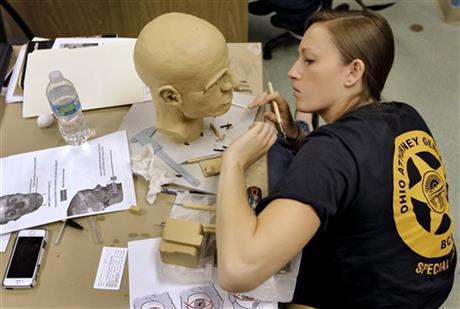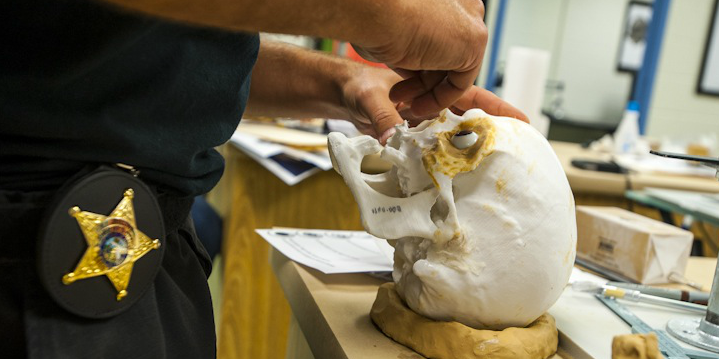 3D printing has become an invaluable tool in literally reconstructing the past. Recently, it was put to use in potentially solving the in some instances decades-old cold cases of various Florida law enforcement agencies. Instrumental in the effort was Joe Mullins, a well-known forensic imaging specialist and artist who works for the National Center for Missing and Exploited Children. The center offered a week-long course to law enforcement agencies in the Tampa area as well as students of the USF’s Institute for Forensic Anthropology and Applied Science (IFAAS).
3D printing has become an invaluable tool in literally reconstructing the past. Recently, it was put to use in potentially solving the in some instances decades-old cold cases of various Florida law enforcement agencies. Instrumental in the effort was Joe Mullins, a well-known forensic imaging specialist and artist who works for the National Center for Missing and Exploited Children. The center offered a week-long course to law enforcement agencies in the Tampa area as well as students of the USF’s Institute for Forensic Anthropology and Applied Science (IFAAS).

Joe Mullins, National Center for Missing and Exploited Children demonstrating skull reconstruction for students at the University of South Florida in Tampa, Fla. (AP Photo/Chris O’Meara)
Mullins has engaged twelve students to help him identify the victims of nine so-called “cold cases,” some of which have gone unsolved for forty years or more. Of the victims of the nine cases, all from Florida, two were juveniles and seven were adults at the time of death. Mullins and the students work with the remains of the victims, beginning with the skulls, which must be reconstructed based on scientific procedures.
However, as the skulls cannot be tampered with as they are the most important material evidence in each case, they are scanned, 3D modeled, and then 3D printed layer by layer. The 3D printed skulls were created by Dr. Erin Kimmerle, a USF anthropologist and the Director of the IFAAS along with her forensics team. They were 3D printed at the USF Visualization Center.
Once the 3D prints have been produced, clay is placed–also layer upon layer–onto the skulls, slowly and precisely rebuilding the face of the deceased person.
“It’s a bit of a challenge,” remarked Mullins, “to create a face from a skull. You have to have that artistic ability flowing through your body.”
That statement emphasizes the difficulty of the process, which is part guesswork, albeit educated guesswork, scientific know-how, and an artist’s understanding of human anatomy.

Dr. Erin Kimmerle speaking about a case in which she reconstructed the face of a female murder victim found in Lake Panasoffkee, Fla., in 1971 (from a New York Times article; Photo credit Melissa Lyttle for The New York Times)
https://www.nytimes.com/2012/11/13/science/isotope-analysis-provides-clues-in-a-florida-cold-case.html
After the faces have been reconstructed from clay, the students insert eyeballs into the eye sockets and then arrive at what Mullins concedes is one of the more challenging aspects of the procedure: reconstructing the lips. He demonstrated for the students how to use the curve of the face as a guide to create lips that are more realistic. The process is both painstaking and poignant as the students are constantly reminded that their work represents someone’s lost loved one.
“The first thing the artist has to do is take their artistic license and set it aside, because they don’t have any. They have to stick with what that skull is telling them … There’s no wiggle room. An artist can slap a face on here but that’s not going to do any good if you don’t capture the unique characteristics of this individual,” said Mullins. “The hardest part of sculpting the face is the emotional impact it has on you. I stop when I see somebody stare back at me.”
Once the students completed their reconstructions, they exhibited them at an event titled “The Art of Forensics: Solving Florida’s Cold Cases” held at the Interdisciplinary Sciences Building at USF. The exhibition wasn’t merely an event intended to showcase the work of this group of budding forensic scientists, however. There was a larger objective: to potentially reach out to people who may have known the victims in the interest of solving the in some cases decades-old mysteries if not necessarily crimes and to provide closure for loved ones.
In order to provide additional clues as to the identities of the nine deceased persons, Dr. Kimmerle and her team also performed chemical isotope tests and skeletal analyses. At a workshop held in conjunction with the effort and the exhibition, a number of forensic scientists provided their own expertise, including conducting lab work on the nine cases. The exhibition was covered by the Florida media and Crime Stoppers provided a telephone number, which anyone recognizing one of the victims could call. In the event of a crime, they are also offering a cash reward. An article published on the project and the exhibition by the USF campus newspaper also provided images of the reconstructed skulls and general information regarding each case.
On the day of the event, October 16, Hernando County Sheriff’s Det. George Loydgren spoke to the students with whom Mullins had worked, saying, “What you’re doing is fantastic. It’s priceless to be able to identify somebody for a family. Somebody hopefully reported these people missing.” See the USF article for more information on the individual cases. What are your thoughts on this creative use for 3D printing? Let us know in the Cold Cases forum thread on 3DPB.com.
Subscribe to Our Email Newsletter
Stay up-to-date on all the latest news from the 3D printing industry and receive information and offers from third party vendors.
You May Also Like
3D Printing Financials: Fathom Struggles in Financial Quicksand During Critical Transition
Facing a year of key transitions and financial pressures, Fathom (Nasdaq: FTHM) has filed its annual report for 2023 with the U.S. Securities and Exchange Commission (SEC). The document outlines...
Latest Earnings Overview for Australian 3D Printing Firms Titomic and AML3D
Australian 3D printing manufacturing firms Titomic (ASX: TTT) and AML3D (ASX: AL3) reported their financial results for the period from July to December 2023, marking the first half of their...
3D Printing Webinar and Event Roundup: April 7, 2024
Webinars and events in the 3D printing industry are picking back up this week! Sea-Air-Space is coming to Maryland, and SAE International is sponsoring a 3D Systems webinar about 3D...
3D Printing Financials: Unpacking Farsoon and BLT’s 2023 Performance
In the Chinese 3D printing industry, two companies, Farsoon (SHA: 688433) and Bright Laser Technologies, or BLT (SHA: 688333), have recently unveiled their full-year earnings for 2023. Farsoon reported increases...

































